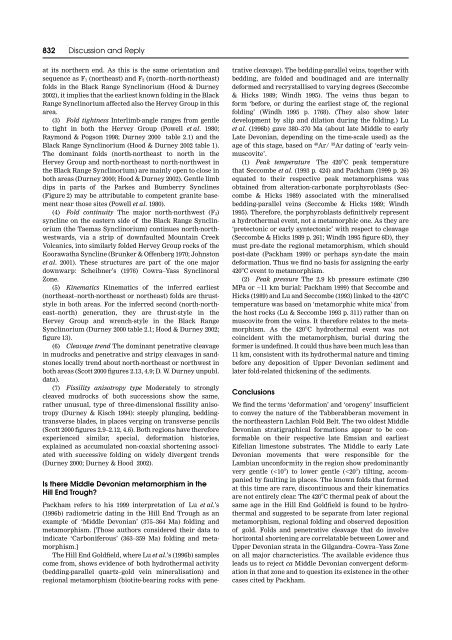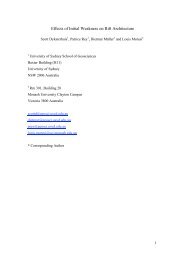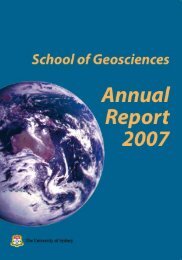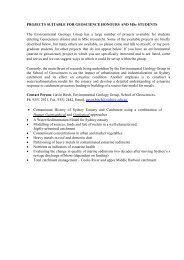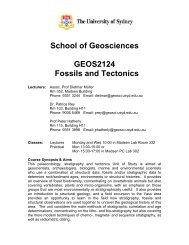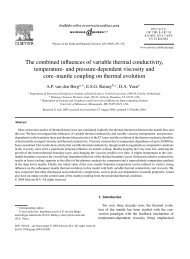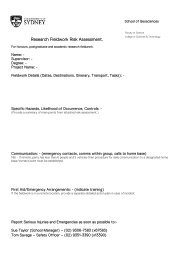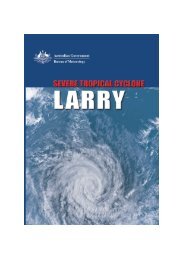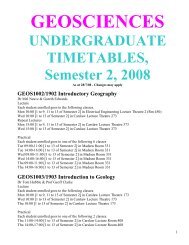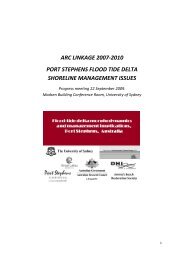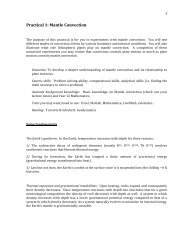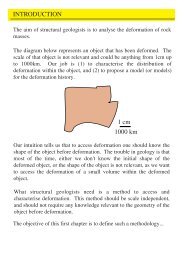View - School of Geosciences
View - School of Geosciences
View - School of Geosciences
You also want an ePaper? Increase the reach of your titles
YUMPU automatically turns print PDFs into web optimized ePapers that Google loves.
832 Discussion and Reply<br />
at its northern end. As this is the same orientation and<br />
sequence as F 1 (northeast) and F 2 (north–north-northeast)<br />
folds in the Black Range Synclinorium (Hood & Durney<br />
2002), it implies that the earliest known folding in the Black<br />
Range Synclinorium affected also the Hervey Group in this<br />
area.<br />
(3) Fold tightness Interlimb-angle ranges from gentle<br />
to tight in both the Hervey Group (Powell et al. 1980;<br />
Raymond & Pogson 1998; Durney 2000 table 2.1) and the<br />
Black Range Synclinorium (Hood & Durney 2002 table 1).<br />
The dominant folds (north-northeast to north in the<br />
Hervey Group and north-northeast to north-northwest in<br />
the Black Range Synclinorium) are mainly open to close in<br />
both areas (Durney 2000; Hood & Durney 2002). Gentle limb<br />
dips in parts <strong>of</strong> the Parkes and Bumberry Synclines<br />
(Figure 2) may be attributable to competent granite basement<br />
near those sites (Powell et al. 1980).<br />
(4) Fold continuity The major north-northwest (F 3)<br />
syncline on the eastern side <strong>of</strong> the Black Range Synclinorium<br />
(the Taemas Synclinorium) continues north-northwestwards,<br />
via a strip <strong>of</strong> downfaulted Mountain Creek<br />
Volcanics, into similarly folded Hervey Group rocks <strong>of</strong> the<br />
Koorawatha Syncline (Brunker & Offenberg 1970; Johnston<br />
et al. 2001). These structures are part <strong>of</strong> the one major<br />
downwarp: Scheibner’s (1976) Cowra–Yass Synclinoral<br />
Zone.<br />
(5) Kinematics Kinematics <strong>of</strong> the inferred earliest<br />
(northeast–north-northeast or northeast) folds are thruststyle<br />
in both areas. For the inferred second (north-northeast–north)<br />
generation, they are thrust-style in the<br />
Hervey Group and wrench-style in the Black Range<br />
Synclinorium (Durney 2000 table 2.1; Hood & Durney 2002;<br />
figure 13).<br />
(6) Cleavage trend The dominant penetrative cleavage<br />
in mudrocks and penetrative and stripy cleavages in sandstones<br />
locally trend about north-northeast or northwest in<br />
both areas (Scott 2000 figures 2.13, 4.9; D. W. Durney unpubl.<br />
data).<br />
(7) Fissility anisotropy type Moderately to strongly<br />
cleaved mudrocks <strong>of</strong> both successions show the same,<br />
rather unusual, type <strong>of</strong> three-dimensional fissility anisotropy<br />
(Durney & Kisch 1994): steeply plunging, beddingtransverse<br />
blades, in places verging on transverse pencils<br />
(Scott 2000 figures 2.9–2.12, 4.6). Both regions have therefore<br />
experienced similar, special, deformation histories,<br />
explained as accumulated non-coaxial shortening associated<br />
with successive folding on widely divergent trends<br />
(Durney 2000; Durney & Hood 2002).<br />
Is there Middle Devonian metamorphism in the<br />
Hill End Trough?<br />
Packham refers to his 1999 interpretation <strong>of</strong> Lu et al.’s<br />
(1996b) radiometric dating in the Hill End Trough as an<br />
example <strong>of</strong> ‘Middle Devonian’ (375–364 Ma) folding and<br />
metamorphism. [Those authors considered their data to<br />
indicate ‘Carboniferous’ (363–359 Ma) folding and metamorphism.]<br />
The Hill End Goldfield, where Lu et al.’s (1996b) samples<br />
come from, shows evidence <strong>of</strong> both hydrothermal activity<br />
(bedding-parallel quartz–gold vein mineralisation) and<br />
regional metamorphism (biotite-bearing rocks with penetrative<br />
cleavage). The bedding-parallel veins, together with<br />
bedding, are folded and boudinaged and are internally<br />
deformed and recrystallised to varying degrees (Seccombe<br />
& Hicks 1989; Windh 1995). The veins thus began to<br />
form ‘before, or during the earliest stage <strong>of</strong>, the regional<br />
folding’ (Windh 1995 p. 1768). (They also show later<br />
development by slip and dilation during the folding.) Lu<br />
et al. (1996b) gave 380–370 Ma (about late Middle to early<br />
Late Devonian, depending on the time-scale used) as the<br />
age <strong>of</strong> this stage, based on 40 Ar/ 39 Ar dating <strong>of</strong> ‘early veinmuscovite’.<br />
(1) Peak temperature The 420C peak temperature<br />
that Seccombe et al. (1993 p. 424) and Packham (1999 p. 26)<br />
equated to their respective peak metamorphisms was<br />
obtained from alteration-carbonate porphyroblasts (Seccombe<br />
& Hicks 1989) associated with the mineralised<br />
bedding-parallel veins (Seccombe & Hicks 1989; Windh<br />
1995). Therefore, the porphyroblasts definitively represent<br />
a hydrothermal event, not a metamorphic one. As they are<br />
‘pretectonic or early syntectonic’ with respect to cleavage<br />
(Seccombe & Hicks 1989 p. 261; Windh 1995 figure 6D), they<br />
must pre-date the regional metamorphism, which should<br />
post-date (Packham 1999) or perhaps syn-date the main<br />
deformation. Thus we find no basis for assigning the early<br />
420C event to metamorphism.<br />
(2) Peak pressure The 2.9 kb pressure estimate (290<br />
MPa or ~11 km burial: Packham 1999) that Seccombe and<br />
Hicks (1989) and Lu and Seccombe (1993) linked to the 420C<br />
temperature was based on ‘metamorphic white mica’ from<br />
the host rocks (Lu & Seccombe 1993 p. 311) rather than on<br />
muscovite from the veins. It therefore relates to the metamorphism.<br />
As the 420C hydrothermal event was not<br />
coincident with the metamorphism, burial during the<br />
former is undefined. It could thus have been much less than<br />
11 km, consistent with its hydrothermal nature and timing<br />
before any deposition <strong>of</strong> Upper Devonian sediment and<br />
later fold-related thickening <strong>of</strong> the sediments.<br />
Conclusions<br />
We find the terms ‘deformation’ and ‘orogeny’ insufficient<br />
to convey the nature <strong>of</strong> the Tabberabberan movement in<br />
the northeastern Lachlan Fold Belt. The two oldest Middle<br />
Devonian stratigraphical formations appear to be conformable<br />
on their respective late Emsian and earliest<br />
Eifelian limestone substrates. The Middle to early Late<br />
Devonian movements that were responsible for the<br />
Lambian unconformity in the region show predominantly<br />
very gentle (


